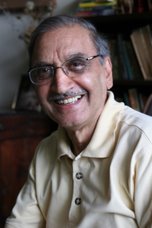Seven kulchas and Seven Nizams
by Narendra Luther
Golconda was captured by Aurangzeb in 1687. It then became a part of the Deccan province of which the capital was Aurangabad.Hyderabad thus lost its primacy in the south. A Mughal governor was appointed for the Deccan.
The First Nizam
Mir Qamruddin was the grandson of Khwaja Abid better known by his title of Qilich Khan. He was a general of Aurangzeb and died due to wounds he received during the siege of Golconda. While he was buried near Himayat Sagar, his right arm blown off by a cannon and was found later and was buried in Qismatpur. His son, Ghazi-ud-din Firoz Jung took the place of his father and served Aurangzeb with distinction. Qamruddin was born in 1671 and at the young age of 20, was given the title of Chin Qilich Khan (meaning small sword) for his courage and bravery.
He rose in the service of the Mughals by his devotion and hard work. While he was the prime minister of the Mughal empire he was also appointed the governor of the Deccan in 1713. He was a remarkable man and was rated highly for his competence and self-respect. He was given the title of Asaf Jah after a minister of Solomon who was known for his sagacity. The dynasty founded by him was thus called Asaf Jahi and ruled from 1724 to 1948.
In one of his journeys to the Deccan, Mir Qamruddin is said to have lost his way in a jungle. Thirsty, hungry and woe-begone, he approached a saint called Shah Inayat for succour. All that the saint could offer him was dry baked bread (called kulcha) and plain water. The exhausted noble had his fill and inspite of the saint's insistence, could eat no more than seven loaves. Thereupon the hermit remarked : "My son you have eaten seven kulchas. Your dynasty will rule for seven generations. God bless you."
It is interesting to note that the first Nizam never declared his independence of the Mughals. On the other hand he affirmed his loyalty to the emperor and advised his son and successor to do likewise. However, by 1724 he was virtually independent.
Although it is said that the Asaf Jahi dynasty lasted only seven generations it is interesting to note that actually there were ten Nizams. However, out of them only seven are counted as proper member of the `Asaf Jahi' dynasty. As noted above, `Asaf Jah' was a title given by the Mughal emperor to the first Nizam. It was not given to the second, third and fourth Nizams who ruled between 1748-1762 and spent all their time in fighting with each other with the help of the French or the British. As a result, when the fifth Nizam, Mir Nizam Ali Khan ascended the masnad in 1762, one third of the territory of the Deccan province had been lost to various powers most of whom had never counted earlier - the English, the French, the Nawab of Karnataka and Hyder Ali. Nizam Ali Khan came to rule the remaining territory as a protege of the English for over 40 years. He was given the title of Asaf Jah and so became Asaf Jah II. From then on the succession was regular and the successive Nizams did not need the specific conferment of the title by a weak Mughal emperor. The Nizams were independent of the emperor at Delhi in all but name. After the War of Independence (`Mutiny') of 1857, the British forced the then Nizam, Afzal-ud-Dowla to proclaim his independence of the Mughal emperor by striking his own coin and having his name read in the Friday `khutba' in mosques. The Nizam complied reluctantly.
Kulcha or Moon on the Flag ?
A legend grew that the Asaf Jahi flag carried the symbol of the Kulcha in commemoration of the incident of his having eaten seven loaves. However, the first Nizam himself dismissed this theory and in his anecdotes recorded by his chief secretary, Lala Mansa Ram, the Nizam stated that actually the flag carried a symbol of the moon. That, in turn, was derived from his own name - Qamaruddin (Qamar means moon). However the tradition persisted and a new design of the flag submitted to Nizam VI was approved by him in 1899 with observationthat the symbol was that of a kulcha. Such is the force of tradition that even a specific denial by the subject could not scotch it.
The Legacy of Wealth
The first Nizam died in 1748. In his will and testament, amongst other things, the first Nizam also said that there was enough money in his treasury to last seven generations, if properly spent. It can't however be said that every Nizam spent money wisely or properly. There were times when the state got into trouble because there was no money in the treasury. This is one of the factors which helped the British strengthen their foothold in Hyderabad. However, the last Nizam had a way of collecting money and spending very little of it. He was, therefore, reputed to be the richest man of the world in his time. The wealth has thus lasted not seven but ten or rather eleven generations so far.
***
Archived by www.mygoldencopy.com
